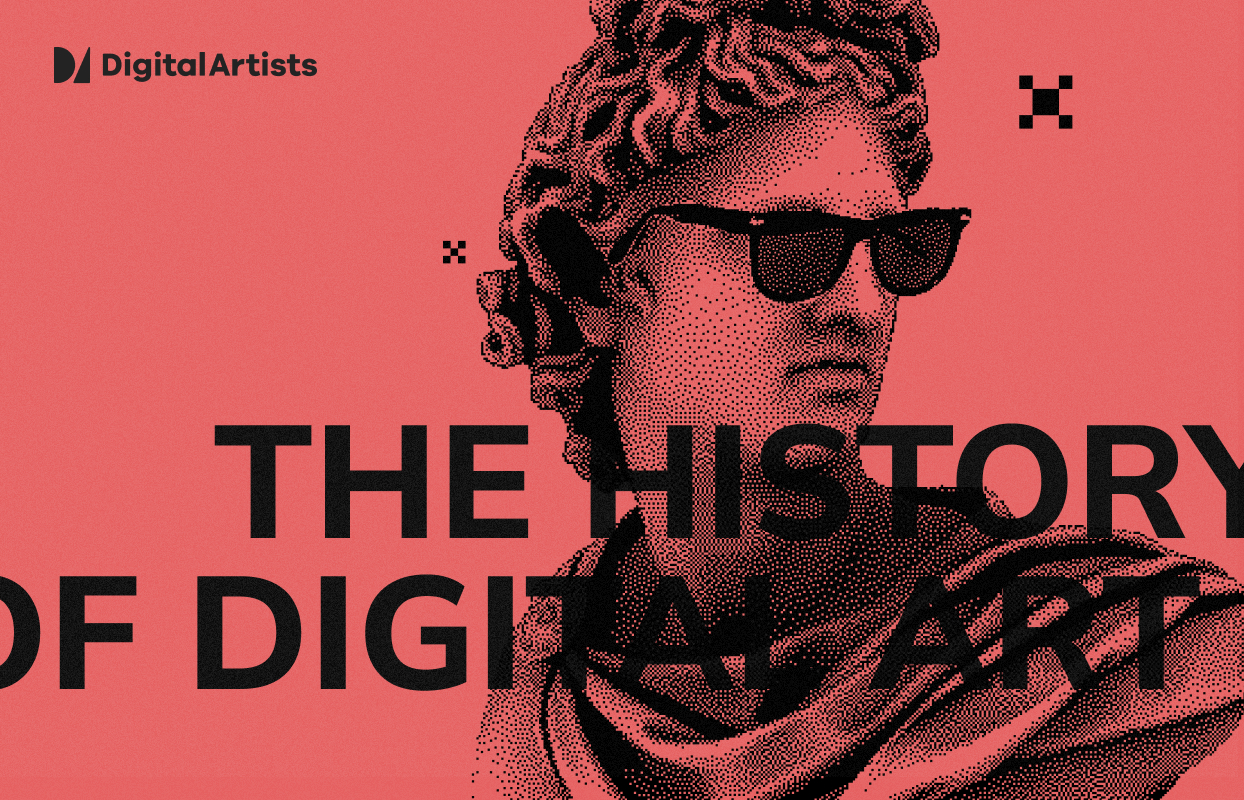


14 MIN. READ
The history of digital art has a fascinating timeline. In this article, we will look into the past and present and see how digital art will change the world forever. In today’s current climate, the word ‘digital’ seems to crop up everywhere. It seems almost every household item has become digitized, everything from lighting appliances to fridges. The whole digital concept came to be in the early 1980’s, around the same time computers came to the marketplace. Both digitalization and computers go hand-in-hand with one another. The rise in both technologies has been quite remarkable over the past 40 years.
It comes as no surprise that the world of art has evolved with the times and digital art is now commonplace. You’ll be far-fetched to locate any TV show or movie that hasn’t used digital artwork in some shape or form in recent years. In today’s article, we will take a look into the history of digital art, understand how it’s adapted to digitization over the decades and visualize what the future holds for artists and content designers alike.
Back in the day, digital art was known as new media art or computer art. In its most simplified terms, digital art is something that is created on an electrical device such as laptop or iPad for example. Here’s some of the most common examples of digital art creations:
Once upon a time, animation used to be created with hand-drawn images, it would take an artist endless hours creating different versions of the same image to create movement. Nowadays, almost all animation is digitally created on a computer. Pixar, probably the most famous animation creator of recent times made their first computer-generated image, or CGI, animated movie Toy Story in 1995.
If you’ve ever used an application on your phone to edit a photo, then you have used digital photography. The very first digital camera came into existence back in 1975. Ever since then, digital photography has turned into a billion dollar Industry. Event creators for celebrations such as weddings and proms spend hundreds of dollars on digital photographers, in the hope they’ll deliver beautiful photos of the big occasion.
NFTs are the most recent forms of digital art. Although the first NFT was created in May 2014, they have only become very popular collectables within the last few years. They are exclusively designed via computer-generated platforms and are generally purchased via Cryptocurrencies. If you would like to learn more about NFTs and how they compare to traditional photography, you can read more in our published article, NFTs vs Stock Photography.
The history of the digital art timeline goes back further than you think. Well before computers were accessible to the general public, in 1954 Ben Laposky used an oscilloscope to generate electronic waves that were projected onto a fluorescent black and white screen. The images were named ‘Oscillions’ named after the instrument used to create them.
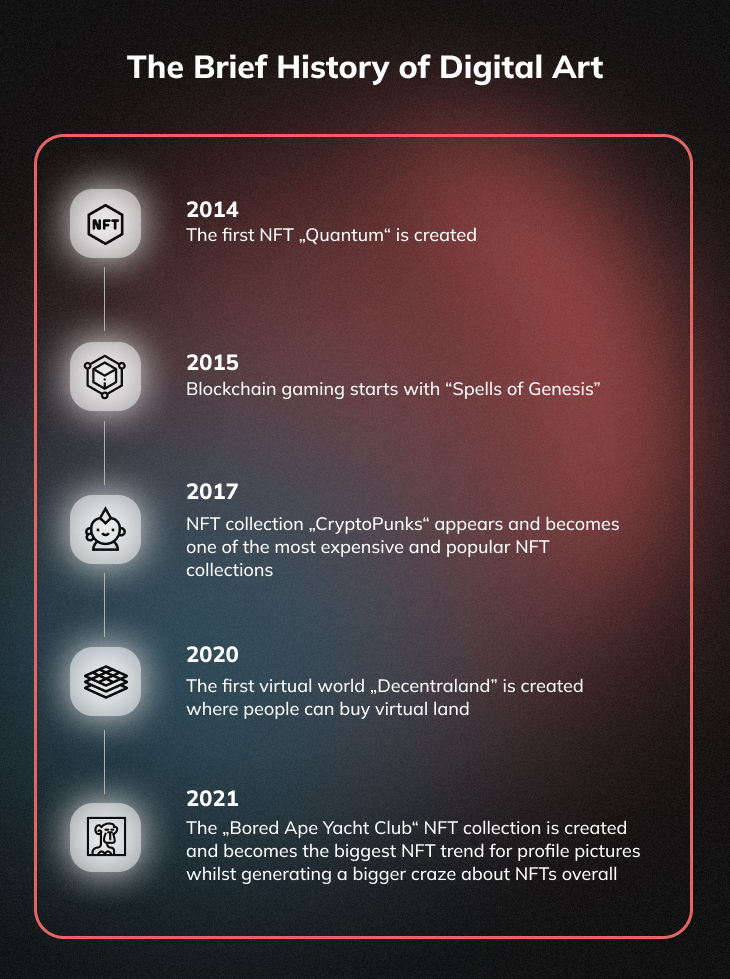
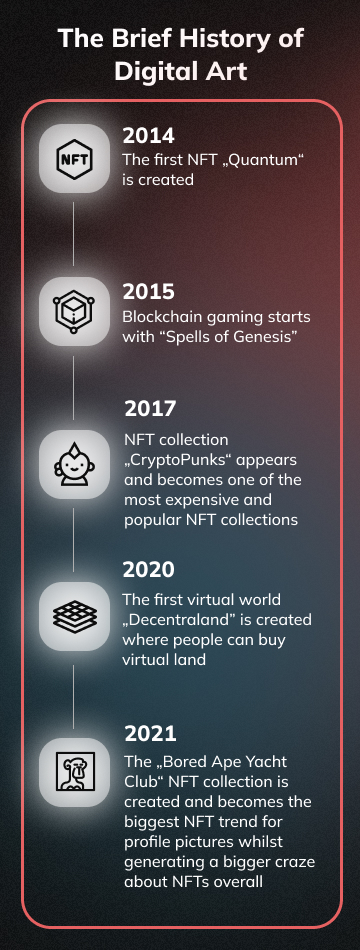
Although it wasn’t computer generated, it’s still considered as the very first digital art image that was ever created. It would be over a decade later until the first computer generated digital art would be created, paving the way for the digital art world we see and love today.
During the brief history of digital art, many art movements, such as Pop Art, became increasingly reliant on mass production of their art. Due to high demand, artists could no longer keep up with the consumer needs and the introduction of technology brought with it a way to spread their art to a larger audience.
Ever since remote collaboration was demoed in 1968 with coded generated art, many industries, such as computer science, engineering and manufacturing have become heavily dependent on digital art technology. Here are some good examples of professions in which the implementation of digital art is fundamental:
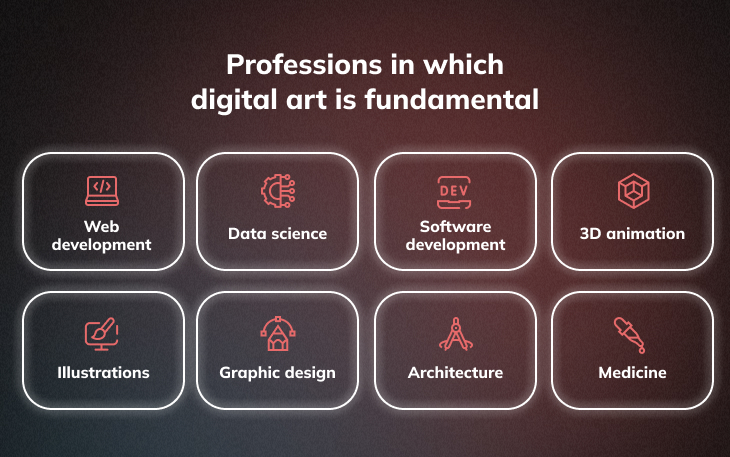
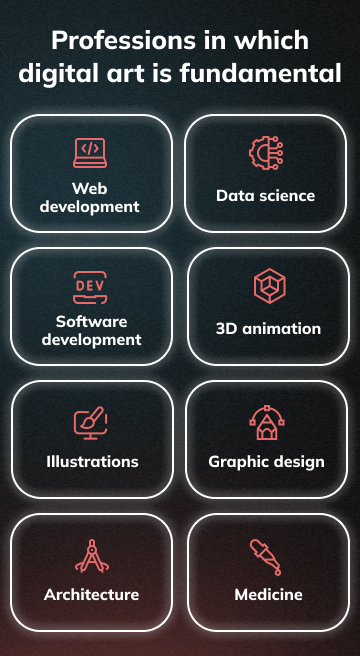
Over the past few decades, ever since the general public has access to the internet, digital art has become almost an everyday occurrence. Everything from photo editing to meme creation can be associated with digital art in some shape or form.
The history of digital art stretches back all the way back to the 50’s. The very first digital image created by a computer was by a man named John Whitney in 1965. Considered the father of computer graphics, John Whitney created his art with mathematical functions, which was then transformed into an image by a computer.
As the 1970s rolled in, digital art really exploded onto the scene. Artwork created by Manuel Barbadillo and Paul Brown required an awful lot of computer programming to create the most basic of digital patterns. However, it’s these very patterns that led to some of the first computer arcade games such as “Pong” and “Space Invaders” that we all know and love. It’s these very games that have shaped the gaming industry into a trillion dollar business.
In 1982, the very first computer-generated movie hit the silver screen. It was called “Tron”. It’s said that the animator Steven Lisberger was inspired to make the movie after he saw the computer game “Pong” for the first time and wanted to create a movie with the same design and technique. A few years later, the pop world would also follow in Hollywood’s footsteps with the digital art music video “Take on Me” by the group A-ha.
Words cannot describe how beautiful of a film Tron Legacy is pic.twitter.com/sQiqR4qcNw
— Sideswipe (@sideswipe_boss) July 30, 2022
The 1980’s were a pivotal decade for the expansion of digital art throughout all aspects of life. Apple and Microsoft appeared onto the scene in the late 1970s and by the 1980s, many households owned their very own personal computer, opening the doors for the general public to start composing their very own digital art creations.
AARON was the brainchild of artist Harold Cohen. Designed with various computer programs, Cohen set out to discover the basic set of rules needed by a computer to create a digital image. The project started in 1972 and ran up until his death in 2016.
Cohen used various machines that allowed AARON to create various digital images. As time passed, the images would become more detailed. The general concept of digital art is for it to be created by a computer and the final design to be projected onto a monitor. The AARON didn’t do that as it was rather programmed to create physical artwork with fabric dye.
As the history of digital arts goes, probably one of the biggest names in the art industry went digital back in 1985. Andy Warhol’s digital art creation of Blondie’s lead singer, Debbie Harry, created a long and lasting impression of where digital art was going.
At the time, digital art was in its infancy and the image sent a seismic wave across the world as to what computers can do in the name of art. Andy Warhol only lived a few short years afterwards, however, many consider his digital art creation of Debbie Harry his most groundbreaking artwork.
With the release of Photoshop in 1990, it brought digital art to the masses. In the history of digital art this was the very first time images and photos could be manipulated by the general public. Since its birth in 1990, there have been over 16 major releases over the next 30 years, making it the most used digital art software in the world, closely followed by Procreate in second place. As Photoshop has advanced so much over the years, these days it’s very difficult to distinguish which pictures have been edited or not – opening the door wide open to the murky world of deep fakes.
As the saying goes, ‘art has no boundaries’ and digital art history has been no different throughout the years. Virtual reality has been around ever since the very first headset named ‘Headsight’ came into existence in 1963.
Technology has advanced incredibly since then and soon virtual reality is said to take over from the internet as we know it today through the Metaverse. The term ‘Metaverse’ was first mentioned in the 1992 book ‘Snow Crash’ and has since grown into a buzzword amongst tech experts ever since the owner of Facebook, Mark Zuckerberg, announced in 2021 he was updating the name of Facebook to Meta.
Announcing @Meta — the Facebook company’s new name. Meta is helping to build the metaverse, a place where we’ll play and connect in 3D. Welcome to the next chapter of social connection. pic.twitter.com/ywSJPLsCoD
— Meta (@Meta) October 28, 2021
Supporters of the Metaverse envisage its users will be working, meeting family and friends, playing and almost living in the digital art reality. Mark Zuckerberg says, he expects the Metaverse to become fully mainstream by 2035. He goes on to say that once key components such as digital walking platforms and more advanced headsets are implemented, that is when the Metaverse will become an everyday platform for its users.
At the very heart of the Metaverse will be NFTs. As we mentioned earlier in the article, at this moment in time, currently they are mainly being used as Digital art collectables, however, due to how NFTs work on the Blockchain, they will soon change the way we purchase both digital and physical assets forever.
The NFTs create smart contracts on the Blockchain and these cannot be edited or changed, essentially, giving the contract parties a bona fide agreement. They will prevent forgeries and take away any third-party intervention which in theory should give the users a better monetary value and protection of their rights.
From the brief history of digital art, it’s easy to see the transition from the early days of Ben Laposky digital artwork “Oscillions” up to the present day and the impending introduction of the Metaverse. Each historical key event has been an integral part of the digital art evolution. Some of them appear irrelevant in today’s digital world, however, it couldn’t be further from the truth. Without the digital tools in art history such as the AARON project or Photoshop, we simply wouldn’t be where we are today.
When we take a glimpse into the future of digital art, we see Artificial Intelligence, or “AI”, combining with the Metaverse to create a new digital art reality. It might sound a little far-fetched, but there’s already AI digital art generators out there such as Midjourney. The AI technology creates digital art based on text inputs, also known as text-to-art. Think of it like a texting platform, however, describe the image you would like, hit enter, and voila – the AI will generate your image. We gave Midjourney a try and the results were truly amazing. You can check them out – just click here.
We are entering the Age of Integration! …The digital artist is the vehicle to that kind of cultural change. We are the first generation of this new breed and we will most surely be remembered…for we bring a quake of expression and technique that makes the art world very uncomfortable and that is as it should be.
Artist – Gene Hirsch
Once you have a good idea how AI digital art platforms work – in a nutshell, they become more advanced or ‘smart’ each time it’s used as they continue to learn from experience, then it’s not too difficult to imagine them being hooked up to the Metaverse at some point in the near future. Giving the users the option to use the technology to create NFTs in the Metaverse, while the AI technology becomes stronger from constant usage. It’s a match made in heaven and the opportunities would be endless and beyond anyone’s imagination.
Throughout the digital art history, each milestone set a new precedent. Everything from John Whitney’s very first digital art image created by a computer to Andy Warhol’s depiction of digital art with his Debbie Harry creation. Each critical milestone is as vital as the last, bringing us countless benefits such as Blockbuster Hollywood movies, Music videos, Augmented reality and the endless applications that can be downloaded to your mobile phone. For example, the billion-dollar gaming industry wouldn’t be in existence if it wasn’t for the forefathers of digital art. It’s quite possible that the Internet as we know it today wouldn’t exist either.
As the internet reaches a new phase with the imminent introduction of the Metaverse, digital art will play a massive role in its transition from Web 2.0 to Web 3.0. With the new groundbreaking technology such as AI art generators and the Metaverse, it’s hard to imagine how big the changes could be and what direction exactly the future of digital art will follow. Whether these digital changes will have a positive effect on population’s everyday life is yet to be determined.
Below we take a look at some of the most frequently asked questions that the general public asked in relation to the brief history of digital art. We hope to answer them the best we can for you.
Believe it or not, digital art has been around since the 1950s, however, it wasn’t until the 1980s and the arrival of personal computers until digital art really became available to the general public. Ever since then, the digital era has evolved immensely and so has digital art.
There are many different examples of digital art. In its most simple terms, it basically is art that has been created on a computer. Digital photos, music videos and movies are some great examples of digital art. The most recent digital art trend is NFTs which seem to be taking on the world by storm.
Yes, it’s true! Andy Warhol was considered as one of the very first digital artists due to his creation of Blondie’s front lady, Debbie Harry. The digital art masterpiece was created on Warhol’s Amiga 2000 computer in 1985 and it remains an iconic image to this very day.
As we have mentioned, NFTs are the most recent digital event. How they operate on the Blockchain opens a huge door of potential within the Metaverse. Soon, digital art tokens will be used as a monetary system throughout the virtual and physical world and their utilization is expected to expand far beyond just digital art.
There’s no doubt about it, digital art has changed the world as we know it. If you think about how computer graphics have changed through the decades, you can only imagine what the future holds. Everything from TV to the way we work can be attributed to digital art in one form or another.